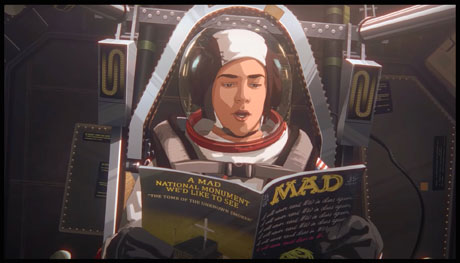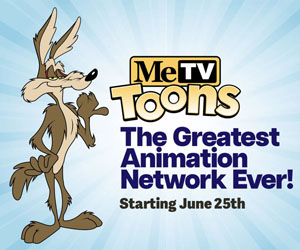
Five-time Academy Award nominated writer/director Richard Linklater (Boyhood, School of Rock) has now made one of his most personal and exciting films to date. Apollo 10½: A Space Age Childhood (now on Netflix) is an animated exploration of being nine years old in 1969 and living near Houston, TX as NASA was getting ready to put a man on the Moon. In this Animation Scoop Q&A, Linklater shares what keeps him coming back to animation and why this is the perfect time for Apollo 10½ to launch. (This interview was edited for length and clarity.)
Jackson Murphy: I love the movie, and I have to tell you I watched it with my father, who was also born in 1960.
Richard Linklater: Whoa.
JM: So the details of being a nine-year-old in 1969 are so spot-on! It’s amazing.
RL: (laughs) Well, if he approved, then I guess that’s the… review I’m looking for.

JM: That’s good to hear. He absolutely approves. And there are so many moments. One of them is the Sunday night gloom of having to go to school the next day.
RL: (laughs) Yes, I always remember that. The weekend was always so fun and then by the time “[The Wonderful World of] Disney was on, it was like, “Oh, bummer.” I realize that wasn’t really fair to Disney. Those shows were really good. But I don’t care how good they were. (laughs) I was always bummed out watching them because the gloom had set in. The dread.
JM: And that montage you do of all the TV show logos is unbelievable.
RL: (laughs) That was so fun, I can’t tell you. “How do we do these?” Okay, if we keep them all on the screen at the same [time]… instead of going through them, it would be like looking in a strobe light that would have to go by so fast. So let’s have them and then we can show the TVs themselves. Every TV has a different physical TV. There were so many different TVs that had been on the market over the years. It was fun on so many levels. It’s the opening credits to every TV show. That was kind of mind-blowingly fun, that sequence. It takes nine months to do, but we get there!
JM: It paid off and it’s a pop culture paradise, without question. We follow Stan in this and his journey. And I think Jack Black’s narration as the grown-up Stan is excellent. We’ve heard him in Kung Fu Panda, Shark Tale and Ice Age, but the rhythm and tone in his voice in this is really special.
RL: Yeah, I thought Jack would be the right tone. This is my third time working with him and he’s such a great guy — a joyous guy. Even when he’s talking serious he has a certain buoyancy, the same way animation itself does. I wanted to keep it pitched at that level. And Jack can find little ironies and put shadings on things that are just inherently funny. There’s a lot of irony in the movie. He’s talking about kids riding around on bikes chasing DDT trucks, basically getting poisoned, but he’s like, “They just hadn’t worked out the chemical thing yet.” He could say it in a funny way. He was a joy to collaborate with on this.

JM: That’s great. As we go through this journey to get to the Moon Landing and we [see] all these characters, we see some other iconic moments and clips of movies. You are converting JFK’s speech, Walter Cronkite and even The Sound of Music and 2001 into animation. Was that conversion really an out of body experience for you?
RL: Yeah, it’s truly mind-blowing to take imagery that we’ve all grown up on that’s kind of iconic… and then invite them into our world that we’re creating to join us on our terms of how we look in our fantasy world / our recreation / our animated world. It was wonderful. It was kind of exhilarating, really, to reimagine that and invite it into us. My goal was it all works in your head in the same place. Live-action was too literal. I don’t think the fantastical elements in the film… I didn’t want people judging that. I wanted you to buy into this recreation and the fantasy — that whole story: the recreation of the time and the fantasy together. I just thought that would work all well in your brain.
JM: Oh yeah, you made a great decision in making this be animated. And it’s been 16 years since your last animated movie A Scanner Darkly. So how were you studying animation? Were you really studying animation a lot as you were making many of your other very successful live-action films, over the 16-year period and as you were prepping for this?
RL: Yeah… I’m just really grateful… I understand animation. I’m interested in it. And I feel like it’s one more means of expression. What do you do as a filmmaker? You’re just trying to tell a story and you’re trying to decide how the audience should take-in that story? I’m glad I have animation as one of my expressive colors on the ol’ storytelling palette, you can say. I’m like, “This should be animated.”
But Tommy Pallotta, my partner in this, we had developed a thing about 10 years ago. Scanner felt like the end of something. I didn’t really want to try to get that look again, but we had kind of advanced it. We had developed another film that didn’t happen. This is about 10 years ago. We had some R&D money and the technique kept evolving and his company in Amsterdam has kept doing stuff. So I just keep up with what I can do. I admire animation. I look at Pixar movies and go, “Oh wow.” But I’m not interested in doing one of those. I’m just interested in how I can use the techniques that I feel are closer to me.
JM: Sure. You save some story surprises for the third act, which I think is brilliant. And the way you do the parallels and some of the big reveals is beautiful. Was that always part of the plan — without giving it all away here — to do what you do when you do?
RL: Yeah. You’re trying to tell a story that makes sense and is effective. It’s storytelling, and in this case you could say we’re weaving three different worlds — they’re happening on top of each other here. You gotta time them all out. That’s kind of the fun of it. Think of it as an orchestra. You’re just playing the certain notes and instruments at the right time.

JM: And I’m sure NASA is, by now, used to having respected filmmakers like yourself come-in and want information and spaces for their movies and TV shows. But what was your specific relationship with NASA like as you were making this?
RL: I love NASA. I can’t say how much I love NASA. My whole life they’re my favorite government agency by far. And actually, it’s been amazing to be able to work with them. To grow up in the shadow of NASA as a little dreamy kid and then here as an adult work with them. They’re so generous and so supportive. We had a screening the other night at NASA. And they liked the movie. They showed it on the International Space Station… or made it available. Really cool. I interviewed a couple astronauts. Jack Black and I and Glen Powell talked to some astronauts on the Space Station.
JM: That’s one of the great seals of approval you can ever have when it comes to making a movie. And talking to astronauts, wow.
RL: They’re the government, so they can’t “promote” your thing, but you can tell they got a kick out of it.
JM: When you were talking with the astronauts, what blew your mind the most?
RL: You always forget what special human beings they are. People say, “Did you want to be an astronaut as a kid?” I say, “Yeah, when I was in 1st Grade.” But by 5th Grade, I knew I didn’t have the math / science brain. People forget what’s required of an astronaut. Those guys are engineer / physicist type people. They’re brilliant and they’re perfect in body and mind and background. They’re so impressive. That’s what I’m reminded of: just what badasses they are.
JM: (laughs) I feel like I would’ve loved to have seen a movie like this when I was in grade school. What do you hope today’s nine year olds (up to high schoolers who I think will learn so much about the ’60s and space)… get out of Apollo 10½?
RL: To be transported to a time that was pretty exciting, culturally and historically. That’s always fun. But there’s this dreamy element too that I hope all kids always have access to — that your childhood’s enough that you can have the fantasies that Stan has in this movie. That you can feel that wonder at the world. There’s something going on in the world that’s captured your imagination, and that’s why I’m always really pro exploration. It’s a really exciting time. Artemis I is about to take off. We’re going to the Moon. We’re going back. And there’s plans for Mars. We’re entering into the new phase to be excited again. I know kids’ imaginations will be… aflame with this. I certainly hope so. I don’t know how you can’t. It’ll be exciting. And I’m glad it’s all happening again.
- INTERVIEW: The Unique Nature Of “Thelma The Unicorn” - May 15, 2024
- INTERVIEW: The Editing And Cinematography Of “Inside Out 2” - May 14, 2024
- INTERVIEW: Strap In For “Mars Express” - April 30, 2024


 April 2nd, 2022
April 2nd, 2022  Jackson Murphy
Jackson Murphy  Posted in
Posted in  Tags:
Tags: 







